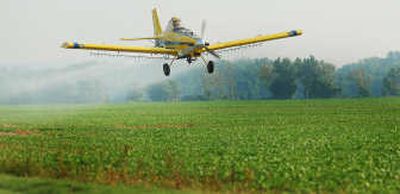New crop of fliers needed

WEBBERS FALLS, Okla. — Paul Gould is a pilot in a career that could be flying into the sunset.
His dad was a crop-duster; he didn’t want the same for his son.
But Paul loved the work too much. Still does, but worries at 49 who will take over when his heart gets weak or eyesight fuzzy.
With the culture of the American family farm changing, and the next generation of crop-dusters reluctant to stay in a profession their fathers inherited from their grandfathers, the industry is at a crossroads.
Crop-dusting, a job that is so much a part of Americana, is graying. The average pilot age is about 60 and more than three-fourths of operators have 16-70 years of experience, according to a survey by the Environmental Protection Agency. Ten to 15 years ago, there were around 4,000 crop-dusting pilots. Today, the figure’s declined by 20 percent.
“I’m one of the younger ones,” Gould said, summing up the crisis.
As the decades-old industry takes stock of how it skipped a generation, it must compete for recruits with the commercial airlines, where the pay and hours are better.
Technology has become a foe, too. Million-dollar planes can fly farther and haul more chemicals, but have priced some mom-and-pops out of the business, some pilots say.
Genetically modified crops, such as worm-resistant corn, are also cutting into business in several states.
And there’s crop-dusting’s reputation as one of the most dangerous jobs in the U.S. because pilots must fly so low to the ground and navigate trees, power lines and other hazards.
“Right up there with rodeo bull-rider,” said Glenda Gould, the other half of Paul’s operation.
Four-thirty a.m. and Paul’s out of bed.
Fast, but not like it used to be, when a seven-day work week didn’t ache as much and the jobs weren’t so big.
Minutes later, he’s behind the controls of the 1980 Piper Brave, the yellow beauty nicknamed the dump truck.
Then, the ritual: swooping insanely low to the ground, spraying, pulling up over acres of shoulder-high corn. An aerial ballet at 130 mph that still makes his wife cringe to watch it.
There’s been a crop-dusting business in Webbers Falls, an eastern Oklahoma town of 720, since 1949, and Gould’s is the only operation for 100 miles.
But it’s not a question of the work. It’s how long can he — and hundreds like him in the business — hold out until the next wave comes up. Five years? Ten?
He figures he can fly well into his 60s, maybe even 70, if he has to.
Fast, but not like it used to be.
These days, “you’ve got to look twice before you get in the business,” warns Jim Criswell, a professor in the department of entomology and plant pathology at Oklahoma State University.
To most Americans, their image of crop dusting is Cary Grant fleeing a low-flying plane in Alfred Hitchcock’s “North by Northwest,” but this dirty, sweaty line of work began as an experiment 86 years ago in Ohio. Trying to get rid of pesky moth larvae, a two-seat plane called a Jenny dropped insecticide made with lead over the affected area. The environmental impact of using such toxins would not be realized until much later.
The industry flourished after World War II, as returning veterans found work during America’s agricultural boom of the 1940s and 1950s. Surplus military planes were enlisted to do the jobs.
By the 1980s, most powdered chemicals were replaced with liquids, and the term “crop-duster” fell out of fashion, replaced by “aerial applicator.” GPS systems in plane cockpits substituted for a pilot’s guesswork.
Today, the greatest deterrent for a young pilot wanting to break into the business is how hard it is to get insured. You need 250 hours of flight time to get a commercial pilot’s license, and up to 1,000 hours before a company insures you.
Enough claims can break a small business, since there’s only a handful of companies in the U.S. that write policies for crop-dusters.
So pilots in training must start out with the tedious work on the ground — cleaning and loading planes — and work their way up into the air.
“That’s probably where we’ve fallen down as much as anything, we have probably raised the entrance barriers high,” said pilot Rod Thomas, who co-owns a helicopter spray business in Gooding, Idaho, and has more than 30 years in the business. “It’s a tough industry to get into. Equipment is expensive, insurance is expensive.”
Once the newbies break in, keeping them in proves even tougher.
Gaylon Stamps took the reins of his dad’s spray business in Panhandle, Texas 32 years ago, and trained his son in hopes he would take over for him. But he decided to go to work for Southwest Airlines after notching 1,000 hours of flight time.
“My son thought he wouldn’t get nearly as sweaty in the cockpit of a 737,” Stamps said.